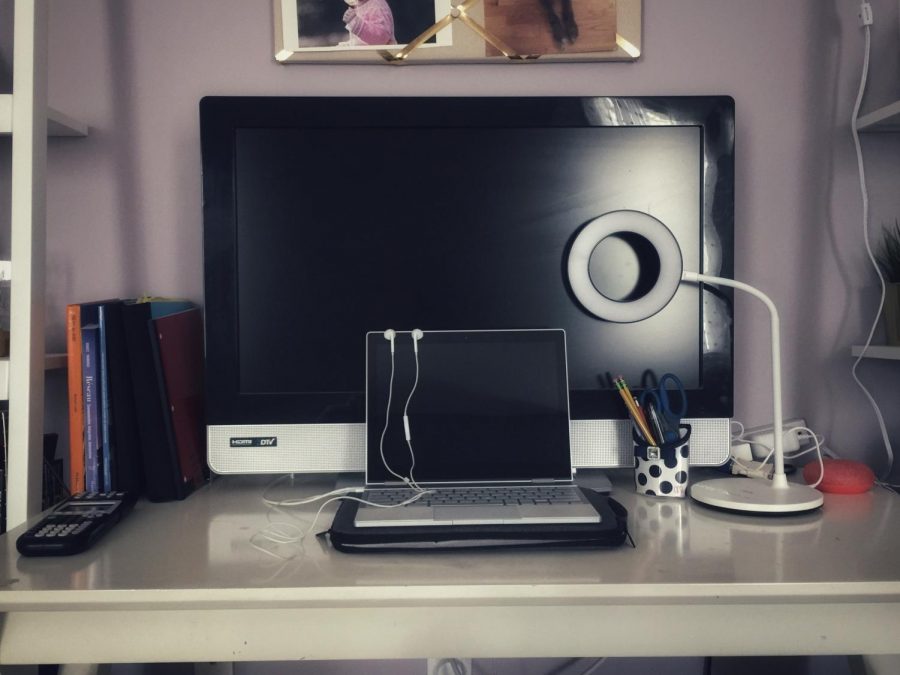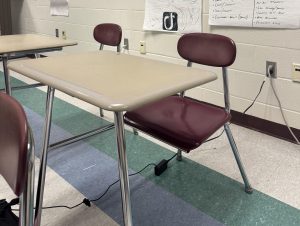How the Class of 2022 are Handling Remote Learning
This remote learning space belongs to Ava Chretien, who just recently switched to remote on the switch day. The setup aids her in continuing to learn just like she would if she was in-person. “As far as education goes, I believe the HBHS teachers have been doing a really good job at keeping remote students involved during classes,” said Chretien.
November 9, 2020
At HB, the first remote/in-person switch day happened on Tuesday, Oct. 13. The switch day allows students to switch between in-person and remote only on that day, but the real surprise was that more students wanted to switch to remote than come back to in-person learning.
Principle Rick Barnes said that as a school, HB is about 80% of the students in-person to 20% being remote. “However, there were more requests to switch to remote than in person,” said Barnes. “The feedback I have received overall has been very positive.”
Ava Blazonis ’22 has been remote all along; she feels that remote is an excellent alternative to being in-person, but could use some tweaks. “I’m still able to get my work done on time, but I do feel I get more distracted/bored while on zoom compared to at school,” said Blazonis. “Sometimes the teachers forget to give the remote students information (such as changes in due dates) and in general, we are usually their second focus. I wish the teachers paid a little more attention to us.”
The main issue concerning many parents and teachers, including Principal Barnes, is the amount of time spent on screens. “I am sure it is difficult to be in front of a screen for most of the school day,” said Barnes. “Perhaps over time, there will be a way to be synchronous without spending as much time in front of the computer screen.”
“I wish that the in-person students could be heard just as easily as remote students. Teachers started using speakers in classrooms before I went remote, and I think that’s great, but the remote students are still having trouble hearing the in-person students. Relaying this information is key to facilitating remote learners through this tough time.” said Ava Chretien ‘22
However, some pros to remote learning are that it has led to decreased anxiety for some students. “The lack of social activities, presentations, and group projects has made me less nervous,” said Blazonis. The switch to remote has its silver lining. “I definitely enjoy sleeping in, not needing to wear a mask, not carrying my backpack, and staying warm in my house. It’s also easier to wear my glasses without a mask. However, I miss having lunch and classes with my friends,” said Chretien.
Chretien shared her opinions on the school’s safety plan for COVID-19 as well. “I believe that our school did a good job enforcing the COVID-19 restrictions, and most kids were very safe in the classrooms. The main exception I think would be during lunch, when kids were less safe and sat closer than they would in classrooms,” said Chretien. She believes that “As far as education goes, I believe the HBHS teachers have been doing a really good job at keeping remote students involved during classes. While I’m not getting the same services that I did in-person, I have found the online learning education better than last year’s. Now that remote students are required to be on zoom, we get to experience what the in-person students are experiencing, we just aren’t in the same learning environment.”
The next remote switch day of HB is on Nov. 23. For more information on the negative effects of screen time visit Johns Hopkins or Science News for Students. For more information on how screen time can negatively impact a teen’s mental health, visit Roger’s Behavioral Health.














